Oubapo-America: a time capsule
A 3-way interview from 2002 using this new technology called "Instant Messenger"…
Welcome back to the Labyrinth of Constraints!
My collection of constrained comics, Six Treasures of the Spiral: Comics Formed Under Pressure, will be in stores on October 28! In the meantime, you can pre-order now from Uncivilized Books.
Tritina Comics Report
I led a workshop on making tritina comics to an enthusiastic room of around 30 people at SPX on a recent Saturday. I shared some photos and comics on my Instagram. Thanks to everyone who showed up, I had a great time!
A Millennial Chat about Comics and Constraints
In my last newsletter, I wrote about how I discovered the French group Oulipo, Workshop for Potential Literature, and its comics offshoot, Oubapo, Workshop for Potential Comics.
In the early oughts, inspired by our discovery of Oubapo, my friends Tom Hart, Jason Little and I started a group we called Oubapo-America with the goal of sharing and promoting the use of constraints for making comics in the anglophone world. We had a website for a few years and presented at an academic conference before moving on to other projects… I’ll say a bit more about the group’s history in a post script for those who are interested but for now I want to get to the fun part.
In early 2002, Anne Elizabeth Moore, whom we knew from her stint as co-editor of The Comics Journal, invited us to do a self interview for her short-lived magazine, Matte, which she later described as “a very good magazine, although square.” (Unfortunately, I no longer seem to have a hard copy to show you, despite my usually excellent archival habits.)
I believe it was Anne’s idea to have us record a conversation using this new technology called Instant Messenger. These days, my teenagers regularly call me a Boomer (not even showing the courtesy of correctly calling me a Gen Xer!) and boy do I sound like one here as I try to figure out how to navigate this (then) new platform.
What follows is the full conversation between myself, Tom, and Jason as it unfolded online and was later printed in the second issue of Matte magazine in April 2002.1
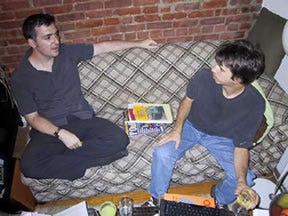
JASON LITTLE: I suppose for the sake of clarity we should begin at the beginning, mention Oulipo etc.
TOM HART: Is Matt on yet? I got an invite to “talk” by “Matt”
HART: OK I will invite him
Matt has entered the room.
HART: oh neat
MATT MADDEN: Is this where I type?
LITTLE: yes
MADDEN: WTF?!
LITTLE: World Trade Fuck?
MADDEN: I’m just going to write like I’m a character out of My New Fighting Technique Is Unstoppable.2
HART: hahaha
LITTLE: OK, maybe we should talk about Oubapo.
HART: yes
MADDEN: yeah, but without using the letter g
LITTLE: Earlier I suggested we start from the beginn–um, start.
HART: I say yes to the G thing.
LITTLE: OK!
MADDEN: I was jokin’ but hey let’s try it out.
HART: yeah, lets.
MADDEN: OK who knows cute IM stuff for our hip Matte readers?
MADDEN: Isn’t IM shorthand a form of Oulipian constraint?
HART: haha
LITTLE: So a bit of a preliminary question—when did you each hear about Oubapo, or even Oulipo?
HART: I was a fan of Italo Calvino3 via Jon Lewis.4
MADDEN: I discovered Raymond Queneau’s Exercises in Style5 many years back, and from there I slowly discovered the world Oulipo, with Perec a recommendation while at a bookstore job—I didn’t actually read him ’til recently and now I’m in love.
LITTLE: OK so Matt, it was thru Queneau, Tom thru Calvino, and me thru Perec.6 A triumvirate of sorts
MADDEN: That’s perfect!
HART: Jason—so you had heard of A Void7 then? Or the French version?
LITTLE: My first exposure was actually on my first date with Myla.8 A large part of the evening was spent with her showing me her neat books, which included Hopscotch by Julio Cortázar,9 and Life a Users Manual by Perec.
HART: Funny—I never realized that just the use of constraints would make one work more consciously. somehow i was so wrapped in the novel RESULTS that I didn't realize that the PROCESS would be more conscious, which is in the end, the most valuable experience an artist can have.
LITTLE: Hopscotch is a problem for me, in that I found the text uninteresting.
LITTLE: Perhaps it’s just not the best Cortázar with which to start.
MADDEN: I plan to read Hopscotch in Spanish some day but it is a dauntful tome. From what I’ve read, I think Cortázar is best in his short stories, many of which seem to be ruled by obscure systems or rules (see for example “Continuity of Parks,” which I adapted into comics for Top Shelf #7).10
MADDEN: [meta-interview comment: I think this no “g” rule is an excellent example of the kind of positive effect constraints can have: now we have to think very carefully about what we write and thus don’t clutter the dumb IM screen...]
LITTLE: So it was consistently oulipo first, not oubapo?
HART: yes
LITTLE: yes.
MADDEN: Definitely Oulipo first. Tom Devlin11 sent me the first Oubapo bk12 when it came out, unaware that I already knew about Oulipo—I was blown away, since I already had plans to do a comics adaptation of Exercises in Style.13 The revelation of Oubapo in turn made me more interested in Oulipo and I have consequently read a lot more of their stuff.
HART: So what compelled you to the idea of constraints, of Oulipo?
MADDEN: I was fascinated with constraints and other systems without an exact idea of what I was fascinated by (Queneau, Cortázar, Eno...), before I learned about Oulipo and their specific program . . .
LITTLE: Now, did you fellows have any compelling attraction to any anticipatory plagiarist14 cartoonists?
MADDEN: you mean “anticipatory copycats”? I would say yes, but let me think of an example.
LITTLE: Speigelman’s stuff in Arcade15 for me. Cracking Jokes.
MADDEN: Oh yeah, Art’s stuff pre-Maus definitely
LITTLE: Oh none of the seventh letter, yes.
LITTLE: bbbbbbbbbbbbbbbbbbbbbbbbbbbbbb
HART: It’s hard. you lose a whole tense.
LITTLE: That’s the sound of me pryin the seventh letter out of my keyboard.
LITTLE: A flathead screwdriver does the trick just fine.
HART: I have to admit—the only AS I saw was “Dead Dick”16 and I didn’t fit with it at all.
MADDEN: you need to see more of that stuff . . . “Dead Dick” is not the best example. Someone needs to reprint Breakdowns17
MADDEN: “The Malpractice Suite” is better every time I read it—I have a copy I can show you
MADDEN: (MS is a comic that uses panels from some dumb newspaper strip and expands, distorts and repeats them as an absurdist cauchemar)
HART: Super. I think for comics, I am drawn to constraints that feed a unique story and tell it uniquely. With “Dead Dick,” for instance, I didn’t feel I’d read a story…
MADDEN: some other 60s cartoonists played with formal constraints too, like S Clay Wilson (surprisin; but true—see early Zaps)
HART: Really?
LITTLE: I also find it invioratin and demoralizin that the very earliest cartoonists were wildly formally experimental. It makes it seem as thouh we’ve achieved little since then.
LITTLE: McCay18 of course.
MADDEN: I think we need more specific examples for our readers?
MADDEN: How does McCay use constraints? for example...
HART: Does he?
MADDEN: Yes, for example: simple visual ones like where the panel stays the same but some element (an animal, a bed) becomes more and more enormous or distorted.
LITTLE: Hmm, this is the eternal question for Oubapo, in that lan8ua8e is more intrinsically mathematical than ima8e.
MADDEN: My McCay example shows an idea of a visual constraint—but you’re correct, it’s not as mathematical.
HART: Jason you’re correct about the formal experimentation (How sad and how we all lament the lack of space on the (newspaper) planche
LITTLE: So lan8ua8e is more easily quantifiably constrainable.
HART: Hmmm. but maybe more simplistically too, and maybe that’s to our favorite medium’s favor
MADDEN: I think Tom has a point about simplicity: this also means that constraints in comics can be more subtle and hidden. I think they can result in richer work because the constraint is perhaps intrinsically more nuanced. Are you of the same opinion?
LITTLE: Indeed.
HART: Maybe.
MADDEN: the problem is that that also includes stuff like Red Meat and The Most Irate Canine in the World, which many think are stupid because of repetition.
HART: Irate!
HART: Others find these stupid or you do too? Where are you headed with that?
LITTLE: They’re not intrinsically stupid, they’re just unori8inal, as the idea has been used before. That is to say it was invented by An8riest Dog. I’m sure Red Meat and Rehabilitatin8 Mr. Wi88les both think they’re bein8 wildly innovative.
LITTLE: I ima8ine the trend will pass.
LITTLE: I’m hopin8 the same will happen to modernism.
Matt: haha
HART: But the banality of an idea “seed” need not result in banal work. It could be transcended.
MADDEN: I make a distinction between repetition out of laziness and repetition that is deliberate and has a sense to it (this is also true of other common visual constraints like appropriated art).
MADDEN: for example…well, early Lewis Trondheim19 and our own Tom Hart (I know you weren’t as repetitive but you used very basic elements in your early minis, correct?)
HART: Only due to a lack of (artistic) resources .
LITTLE: Trondheim said the same thin8.
HART: I suppose I have always tried to work with what I had. A constraint of sorts.
MADDEN: Definitely basic artistic skill is a constraint that you don’t find in many other narrative media
HART: Elaborate.
MADDEN: Even the worst prose writers know syntax, tenses, etc. and a novice director can make a movie without experience with cameras, actors, composition, etc. With comics you need to reckon with this basic skill (to draw) before you can tell a story. If you can’t draw well, you need to find a creative away around that lack. To return to my point of laziness vs. deliberateness, the question is: do you choose the path of least resistance or do you do adapt or innovate with your limited artistic talent?
MADDEN: For example, Matt Feazell20 can draw quite well but at a certain point he decided he preferred to play with the limited means of stick people in nine panel layouts and he’s done a lot of excellent work
HART: What would be a “path of least resistance” in Matt Feazell had he not made that choice? I want to understand your term
MADDEN: By “path of least resistance” I refer to cartoonists who would draw stick people (or some other solution) just because they’re too lazy to draw fully realized work. In Feazell’s case, he did fully drawn comics in the 70s (in Anarchy Comics) but he was frustrated with the results and the amount of work—there was no fun or spontaneity...the thing is he may have started stick people out of frustration but he soon saw limitless possibilities the way Herriman21 saw them in his trio of Kat Mouse and Brick
HART: So it’s a mental path of more resistance, because I’m sure many would claim, the stick characters is an easier art chore.
MADDEN: Oh yes, a mental path
MADDEN: Anyone can draw stick people, but not just anyone can draw a comics with the care that Matt uses when he’s at his best, with only minimal elements at his command
LITTLE: Fellows, I have to admit I haven’t been keepin8 up with the “Silent Runnin8”22 contributions. Have you? How is that 8oin8?
MADDEN: I only saw my students’ work and it was very funny and some a bit profound.
HART: We had some “Silent Runner” submissions on the site but it’s stopped. I have them but haven’t read them

MADDEN: “The Silent Runner” project tests the very problem on the table, ie: is a basic comics constraint like repetition of panels or icons played out or is it a device that continues to be fruitful?
MADDEN: So far so fine, I think
MADDEN: But I also think it’s time to move on to a new tougher constraint.
LITTLE: I a8ree.
LITTLE: Maybe we should discuss that here.
HART: What the French Oubapo have achieved is amazing to me.
LITTLE: Have we only presented transformative constraints?23
LITTLE: No.
LITTLE: Alphabet City24 was 8enerative.25
HART: I have disremembered what the classifications are.
LITTLE: Maybe we could alternate 8enerative and transformative.
MADDEN: yes, time for a constraint that creates new work
MADDEN: One problem with our mission so far is that people think our constraints are “one time only” and if they miss the deadline it’s too late.
LITTLE: mm, yes.
MADDEN: That’s not the point at all...
HART: yes.
LITTLE: We could clarify that.
MADDEN: the point is to create new forms that can be used as people like, like a sonnet or haiku. Some are abstract and hypothetical, but others like Alphabet City, have endless possibilities
HART: I would like at some point to address the issue of mental vs. illustrative constraints. are they different?
MADDEN: mental constraints? Explain . . .
HART: Well maybe it’s an axis and not an either/or situation. An axis with “Silent Runner” on one end and an upside down or fold in story on the other
MADDEN: I’m not sure I follow
MADDEN: you mean a constraint that controls some conceptual approach to the work?
HART: Well, as someone with limited art abilities, I have been keenly aware of constraints that tax my mental abilities and others that tax my artistic ones.
LITTLE: Ah, yes.
HART: But that said, maybe i’m in error.
MADDEN: Aw fuck this, I’m headin’ over 2 the Van Wilder26 Featured Chat Room!
HART: haha
LITTLE: Ha ha! (jowbh)
HART: you can close that window
MADDEN: Oh?
MADDEN: you mean “hide chat extras”?
MADDEN: I assumed that was a chat room for people who are into taxidermy
LITTLE: 8uffaw!
MADDEN: sorry Tom
MADDEN: I think I see what you mean now
HART: Its OK. Anyway, I can’t seem to validate my own mental notion.
HART: I think I am in error.
MADDEN: no you’re OK: maybe it means you are more likely to use constraints that effect the overall structure of the work and not so much the art
LITTLE: But back on topic, half of the constraint ideas I come up with are tailor-made for Bob Sikoryak.27

HART: Ha ha explain.
LITTLE: In that they are artistically challen8in8, and require the cartoonist to imitate a variety of styles seamlessly.
HART: Ah yes—that makes sense. But are they “constraints” or . . . ? what’s the other word?
MADDEN: Exercises in Style certainly shares that with Sikoryak’s work (a great anticipatory copycat BTW) ...as does Jack’s Luck Runs Out28
LITTLE: For example, in the Oupus 1 book, there’s that collaborative story between J.C. Menu and Trondheim in which they find a compromise style.29
HART: Hmmm—I’m not sure I am on to something. But maybe related, I just read “Malpractice Suite” and I enjoyed it much more when I took it in visually like a painted or illustrated product and didn’t try to follow the “story”. The story arose as my eye wandered.
MADDEN: Yes, I think you’re correct in this case. art was really at the limits of comics narrative in this period—there are also explicit pop art overtones (appropriation, use of newspaper strips)
LITTLE: Indeed.
MADDEN: I think Oubapo perhaps favors the visual so far but there are many structural possibilities that don’t rely on art . . . like the cartoonist who draws Zippy the Pinhead’s story “The Plot Thickens” from Raw, also reprinted in Oupus 1. . .
MADDEN: artwork may not be mathematical, but one thing is in comics: panels
HART: Right
MADDEN: In the Plot Thickens, Bill (I call him Bill) increases the panels in each tier until there is a ludicrous amount at the end.
MADDEN: It’s a mathematical constraint, and an excellent example of formalist work in that it is also a parody of melodrama/potboilers/romance comics etc and the way they become overly convoluted in their plot lines.
HART: And its a completely different comic in the end. No narrative images—just symbols.
MADDEN: that’s true, yeah
LITTLE: That allows him to avoid the problem of 8ivin8 the story a “real” endin8, as well.
LITTLE: Endin8s are difficult.
MADDEN: it’s a deliberately “ad absurdum” end though.
MADDEN: . . . yet thematically it refers back to the start (spoons): “My name is Charlie Bendix. I wish I had a spoon.” What an awesome line!
HART: I like it a lot. it does what good constraints should do- it causes a certain kind of story to emerge that wouldn’t have any other way.
MADDEN: Yes, Tom, you’re correct. The best constraints can do that, I believe.
HART: shit I used a G! dammit
HART: 2 of them. I was lazy
LITTLE: 8entlemen, I su88est we break here for the time bein8, if you don’t mind.
MADDEN: Cool, that was some nice oubapian comical analysis,
HART: i’m so mad about that g
MADDEN: we need more of this in the “workshop”—the detailed study of our anticipatory copycats
LITTLE: Indeed.
MADDEN: or open-ended chats like this one
MADDEN: C y’all {giggle giggle!!}
HART: oy vey
MADDEN: OK I’m outta here….
HART: ok bye matt-
LITTLE: Bye matt!
Matt has left the room.
HART: oops he left. I can say G now
HART: G
HART: g
HART: g
HART: g
HART: g
HART: g
HART: whew
Originally published in Matte no. 02, “DIY Renaissance,” April 2002.
Some Oubapian Background
When we formed Oubapo-America in 2001-2002, I was aware that there was a protocol to observe as Oubapo is derived from Oulipo which is derived from the Collège de ‘Pataphysique and a Modernist tradition of secret literary clubs and societies. But I was also impatient an eager to get started…
In 1999 (if memory serves) I went to the Angoulême International Comics Festival and introduced myself to both Jean-Christophe Menu and Thierry Groensteen of Oubapo. I wanted to tell them how much I appreciated their work and to give them photocopies of the first 30 or so of my “Exercises in Style” series which would be later published as 99 Ways to Tell a Story: Exercises in Style. Groensteen has no memory of this encounter, though he has gone on to be a booster of my work and a friend. Menu wrote me a few months after the festival to say that he loved my “Exercises in Style” and would love for L’Association to publish it when it was finished (which they did in 2006—and it’s still in print). I was honored when he said he would want to publish it with the Oubapo logo on the cover (even if I wasn’t made “US correspondent” until several years later).
So, when Tom, Jason, and I decided to start an anglophone Oubapo group, I wanted to be sure to have Oubapo’s blessing and sent an email to Menu to that effect, possibly more than one. I never heard back and we were too excited to wait so we launched the website without explicit acknowledgment from Oubapo.
Over the next few years we had a few meetings and posted some constraint challenges on the website which led to some new friendships and some really great comics. But as time went on, we found it hard to maintain the momentum with so many other projects and jobs to juggle. And this was before we all had kids!
Meanwhile, several other Oubapo websites appeared around the world, which I thought was pretty cool. But at a certain point, Menu and I had a conversation over email where he expressed some concerns about a proliferation of groups claiming Oubapo affiliation. Now, JC Menu has a reputation for being… dramatic but it wasn’t the case in this instance. He was concerned about our responsibility in connection to Oulipo, in particular, which does not really have “franchises” (though in fact there are semi-official German and Italian language offshoots).
I realized that I agreed with Menu and that it made sense for Oubapo to remain its own, integral group, and it caused me to question my own goals in starting Oubapo-America: I wasn’t really intending to start a new group, my aim was to share my enthusiasm for comics and constraints with my peers, readers, and students.
It turned out to be easy enough to reframe the website as being about Oubapo and constraints rather than a competing group.
And then, a few years later, we lost the oubapo-america domain name by accident, we all had kids, we moved on, life went on.
We never officially dissolved the idea of Oubapo-America and we are all still good friends who share a love for comics and constraints and teaching, so I feel like the spirit of our work lives on—perhaps on this Substack more than anywhere else.
Three Things I've Been Enjoying: SPX edition
The Small Press Expo or SPX is one of the longest running independent comics festivals in North America and the one that I feel closest to as I have been an off-and-on attendee since about 1998. I always catch up with old friends, meet young and new artists, touch base with publishers, librarians, academics, and occasionally meet a hero of mine.
And I always come home with a large pile of amazing comics, minicomics, graphic novels, and prints. Here are three that fit the theme of my Substack especially well.
1
Sweat by Jason Little
My friend and colleague Jason was lucky enough to do a residency at Yaddo over the summer and it inspired this brief oubapian tour de force. As he puts it, the comic “contains no characters, backgrounds, or dialogue. What remains is…everything else.”
You can now order Sweat through the excellent Domino Books.
2
Chance Operations (2015) by Todd Webb
Todd Webb has been on my radar for years but we finally met in person at SPX, where he gave me a copy of his fascinating, evocative book Chance Operations which, as you might guess from the title, applies to comics John Cage’s composition procedures based on the I Ching.
This is something I’ve thought about occasionally but I’ve never gotten past the question of how to specifically adapt the binary questions you need for this system to the creation of comics.
(At some point I’m going to write a bit more about Cage and his chance procedures and how I believe they have more than a little in common with Oulipo despite the notion of “chance” being something they aim to eliminate.)
Well, Todd sat down and did the work to came up with a functional system for making comics using Cage’s procedure (tldr version: ask a binary question, toss a coin to determine your answer, move on to the next question). He explains it all in detail here but you can get a sense of how it works in the following page accompanied by its source materials and breakdown:
You can read “Moon Festival” his extended first attempt at using these procedures, here.
3
Everything Is Beautiful, and I Am Not Afraid (2020), by Yao Xiao
Yao Xiao was a student of mine at SVA back in the oughts and we have kept in touch on social media. She is now a professor herself at FIT in NYC and uses my 99 Ways as a teaching tool! It was great to catch up with her at SPX, where she gave me a copy of her book Everything is Beautiful, and I’m not Afraid, which is a series of interconnected short comics exploring notions of queerness, otherness, and family estrangement, in gentle, thoughtfully composed pages which feel poetic.
So I was excited to learn that in fact she did draw from traditional Chinese poetry to think about some of her comics and it so happens she just led an online workshop on the subject for SAW’s excellent Free Friday Night Comics Workshop series, which you can now watch on youtube (as I plan to soon).
Thanks for reading. If you’re not already using the Substack site or app, I recommend it:
Paid subscribers will be hearing from me soon about our next Zoom meet-up.
Meanwhile, I hope you’ll share this post if you enjoyed it and feel free to comment about our interview or any of my “Three Things.” See you soon.
[The footnotes that follow are mostly original to the published interview. New notes/updates are in brackets. I have bolded some “pull-quotes” and added new illustrations and some vintage photos. The illustration captions do not follow the constraint we establish at the beginning of the interview!]
Wise-ass clip art comics by David Rees, anticipatory plagiarist [see footnote #13]. www.mnftiu.cc
(1923-1985) novelist and one of the few non-French members of Oulipo
Cartoonist peer of ours, creator of True Swamp
Not technically an oulipian work but an anticipation of certain concerns of that group (transformation, recombination, word play)
(1936-1982) was not one of the founders of Oulipo but is arguably the one who has created the most fecund and impressive works based on oulipian constraints.
Georges Perec’s 1969 lipogrammatic novel, written without the letter e
Myla Goldberg, Jason’s wife and author of the acclaimed novel Bee Season
(1914-1984) Argentinian novelist and short story writer who shared certain sensibilities with Oulipo, although he declined to join when he was invited.
[and it appears in my new collection, Six Treasures of the Spiral!]
Of Highwater Books, publisher of Matt’s graphic novel, Odds Off
OuPus 1, published by L’Association in 1997
At that point a work-in-progress, https://mattmadden.com/comics/99x/
term coined by oulipo to classify artists who use constraints in their work without being aware of Oulipo
Anthology edited by Bill Griffith and art spiegelman before a.s. started RAW.
story by a.s. from RAW V2, #1
A 1977 book collecting spiegelman’s pre-Maus short work [and it was indeed reprinted a few years ago]
(1869-1934), cartoonist and animtor, creator of Little Nemo in Slumberland and Gertie the Dinosaur, among others
French cartoonist, co-founder of both Oubapo and its publisher, L’Association. His work is published in the US as The Nimrod (Fantagraphics Books)—the title itself is an oulipian confection (it’s an anagram) by anticipatory plagiarist Kim Thompson.
Creator of countless minicomics featuring his stick figure character The Amazing Cynicalman, you can see some of his stuff on line at http://www.mattfeazell.net/CYNICALMAN/
[I’ve long considered George Herriman’s Krazy Kat to be in one sense one of the great oubapian experiments in permutation and recombination.]
A project implemented by Oubapo-America. Four panels with figures but no text, which people can duplicate and add text to make new comics.More here.
A transformative constraint is one that modifies an existing work through some kind of transformation or modification.
The first constraint introduced by O-A. The object is to create a 26-panel comic where each panel has to somehow incorporate its corresponding letter of the alphabet. [I wrote about it in a recent newsletter]
A generative constraint is one that creates a new work (such as Alphabet City or a lipogram)
Sikoryak’s fusions of literary classics and pop comics idioms have appeared in RAW and Drawn & Quarterly.
Jason’s Xeric Grant-funded first book, where all the artwork mimics the scheme of the head cards of a playing card deck.
Jason is referring to an unfinished experiment called “Grabuge galactique” which was actually a collab between J-C Menu and Étienne Lécroart, not Trondheim.

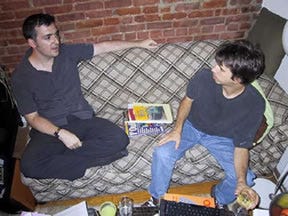




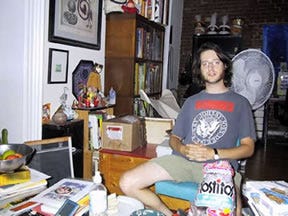




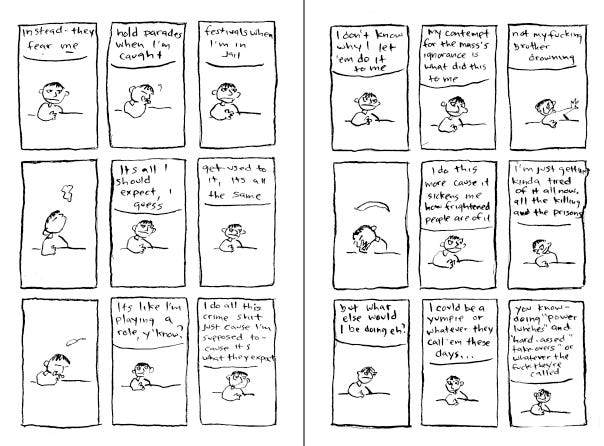




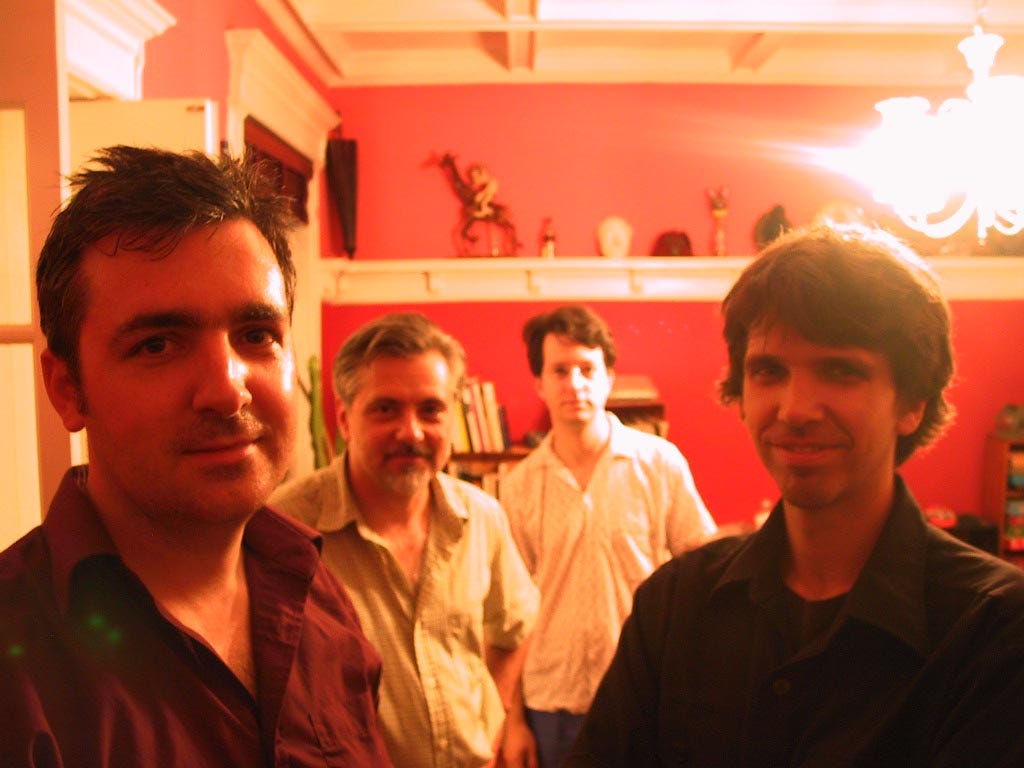






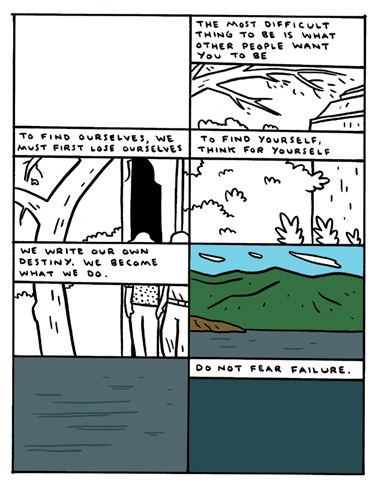
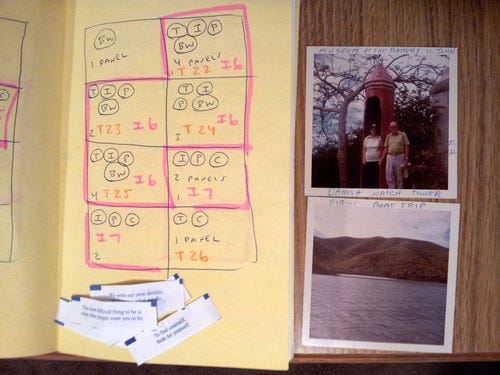
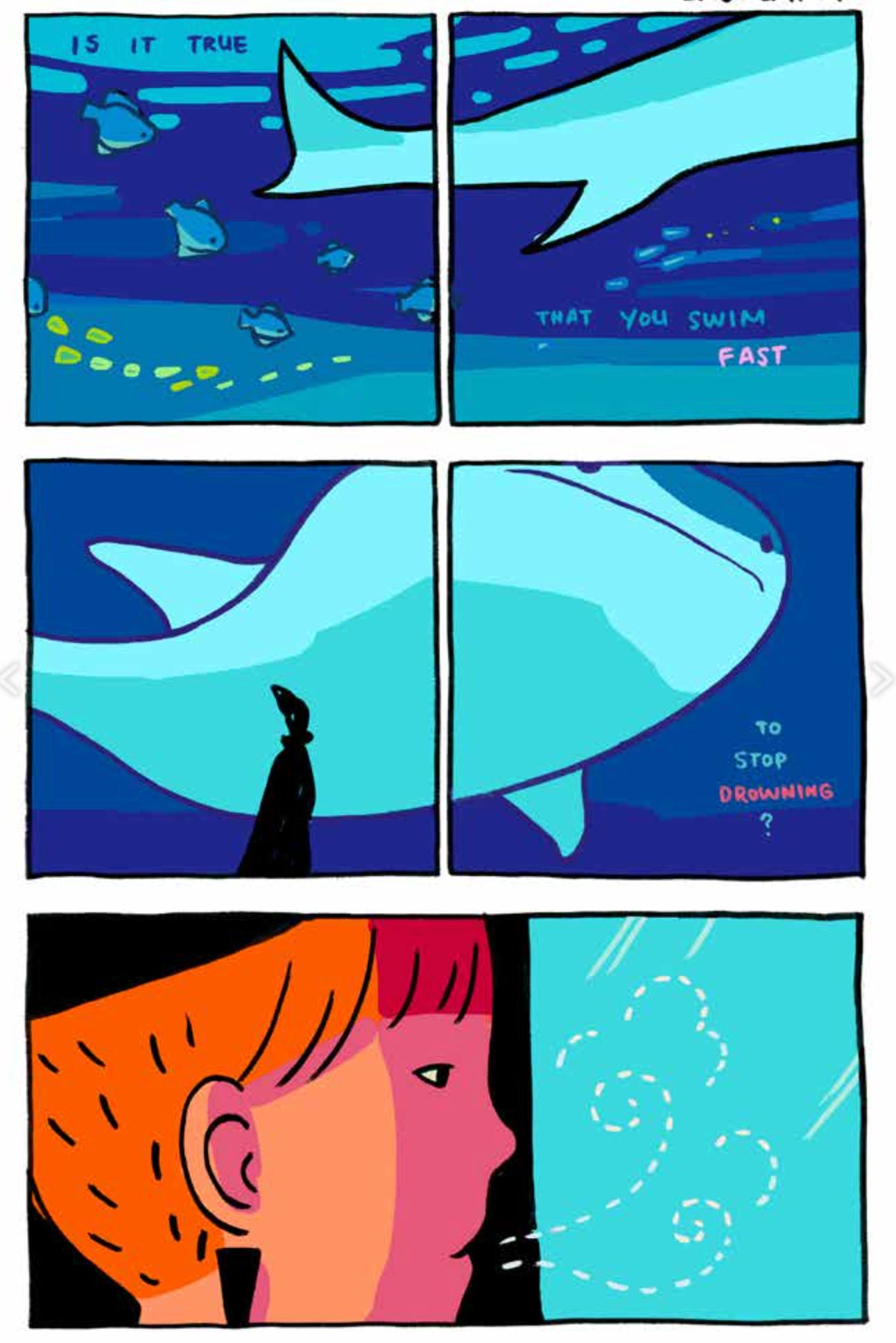

We love conversation about comics and constraints with Tom Hart, Matt Madden and Jason Little
This was AMAZIN88888888